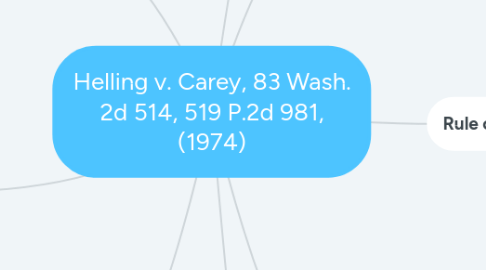
1. Impact
1.1. Chiarino v. United States of America, 189 F. Supp.3d 1371 (2016)
1.1.1. The plaintiff alleges that VA physicians' failure to order CT with contrast and cytology in the evaluation of a patient with gross hematuria,blood in the urine, breaches the duty of care.
1.1.1.1. The court ruled in favor of the plaintiff in that the VA failed to order the CT and cytology that a reasonably prudent health care provider would order.
1.2. Fitzgerald v. Manning, 679 F.2d 341 (1982)
1.2.1. In this case the plaintiff alleges negligence in the treatment of a broncho-pleural fistula. The testimony of the expert witness could not definitively confirm with reasonable medical certainty that negligence by the defendant caused the lung infection.
1.2.1.1. The court ruled in favor of the defendant because causation could not be determined.
2. Importance
2.1. The importance of this ruling is that the court has imposed negligence as "matter of law" because the facts of the case indicated that the profession's standard was inadequate.
2.2. Medical science and standard of care is constantly changing. Treatment that is standard of care for a patient today, may not make a clinically significant difference in outcomes in future literature.
2.2.1. Litigation determinations made on incomplete or outdated science.
2.3. The presence of a test for a particular condition does not always indicate that it should be administered to a patient. Prevalence of disease, positive predictive value of a given test, specificity, sensitivity, and the risks and benefits of both positive and negative results for an individual patient can now be determined in a court of law, rather than a physician's office.
2.3.1. Unnecessary diagnostic testing
3. Influence
3.1. Over-utilization of diagnostic testing to mitigate liability risk.
3.1.1. The use of diagnostic tests are not without inherent risk to patients, and add to the already inflated cost of healthcare.
3.2. Medical Society recommended practice management guidelines.
3.2.1. National medical societies rate the current research publications to set standard of care based on the best evidence.
4. Facts
4.1. Parties
4.1.1. Plaintiff: Ms. Barbara Helling
4.1.2. Defendants: Drs. Thomas F. Carey & Robert C. Laughlin
4.2. What Happened?
4.2.1. 1959- Ms. Helling consulted Drs. Carey and Laughlin for nearsightedness
4.2.1.1. Ms. Helling was fitted for contact lenses at this visit.
4.2.2. September 1963- Ms. Helling consulted the defendants for eye irritation caused by her contacts
4.2.2.1. Ms. Helling's complaint was attributed to her contact lenses.
4.2.3. Ms. Helling was seen by the defendants with concerns about visual problems 9 more times during the period of October 1963 - October 1968.
4.2.3.1. All of the plaintiff's visual complaints during each of these visits were attributed to her contact lenses
4.2.4. October 1968- Dr. Carey tested the plaintiff's ocular pressure and field of vision. Results of the tests indicated that she had glaucoma.
4.2.4.1. Primary open angle glaucoma is a condition where fluid cannot flow out of the eye. This results in damage to the optic nerve and vision loss.
4.2.4.1.1. The 32 year old plaintiff had lost her peripheral vision and her central vision was 5 degrees vertical by 10 degrees horizontal.
4.2.5. August 1969- After consulting other physicians, Ms. Helling filed a complaint agains the defendants alleging that her visual damage was caused by the negligence of Drs. Carey and Laughlin.
5. Issues Before the Court
5.1. The issue in this case is whether the defendants were in compliance with the professional standard of care in the specialty of ophthalmology.
5.1.1. If the doctors adhered to the standard of care, does that protect them from liability regarding Ms. Helling's poor outcome?
5.2. Were the doctors negligent in their care of Ms. Helling?
5.2.1. What would a reasonably prudent ophthalmologist due under similar circumstances?
5.2.1.1. Did Drs. Carey and Laughlin act in a reasonably prudent manner in this case?
6. Rule of Law
6.1. Medical Negligence
6.1.1. Duty
6.1.1.1. A relationship or contract is established between the plaintiff and the defendant.
6.1.2. Breach of Duty
6.1.2.1. The plaintiff must provide evidence that the standard of care was not met.
6.1.3. Causation
6.1.3.1. The plaintiff must show that the injury would not have occurred without the defendant's act or was a foreseeable result of negligence.
6.1.4. Damages
6.1.4.1. The injuries resulted from negligent conduct and determination of what the injuries are worth.
6.2. Strict Liability
6.2.1. Imposes liability without having to prove negligence.
6.3. Reasonable Prudence
6.3.1. If the standard of a reasonable prudence is what is generally done within the standards of the profession.
7. Application of Law
7.1. The plaintiff arguses that she suffered severe and permanent damage to her eyes as a proximate result of the defendants' negligence.
7.1.1. Medical Negligence
7.1.1.1. Did the defendants have a duty to the patient?
7.1.1.1.1. The defendants had an established doctor-patient relationship for 10 years.
7.1.1.2. Was there a breach of duty?
7.1.1.2.1. The plaintiff argued that the standard of care was not met, because the tonometry test was required to diagnose her glaucoma.
7.1.1.3. Can causation be established?
7.1.1.3.1. Failing to do the tonometry testing delayed the plaintiff's diagnosis of glaucoma. This condition is treatable, and earlier diagnosis would have prevented the extensive vision loss.
7.1.1.4. Damages
7.1.1.4.1. 32 year old woman with significant vision loss.
7.2. The defendants argue that the standard of the profession was met, which does not require tonometry to patients under the age of 40. They did not, therefore, conduct the test.
7.2.1. Strict Liability
7.2.1.1. Negligence to the standard of care does not have to be established, because the professional standard was not sufficient in this case.
7.2.1.1.1. Res Ipsa Loquiur
7.3. Given the number of times that Ms. Helling presented with the same complaints, should the defendants have administered the test? What would a reasonable ophthalmologist performed the pressure test, or considered a different diagnosis under similar circumstances?
7.3.1. Reasonable Prudence
7.3.1.1. A reasonably prudent doctor would have widened the differential diagnosis, and done additional testing.
